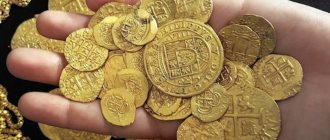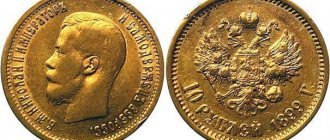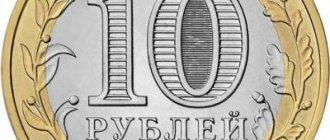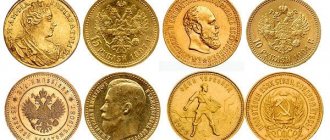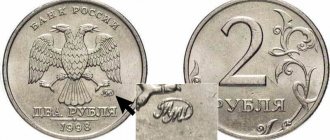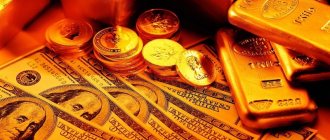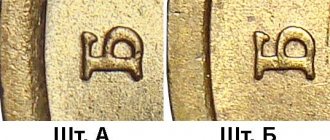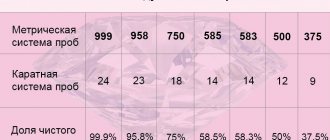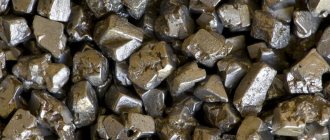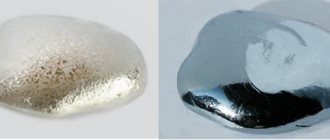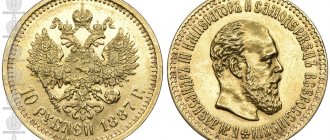In this material:
- Investments in precious metals Purchasing rules
It is unlikely that anyone has come across a gold item with the mark “999”. Does this mean that 999 fine gold does not exist? Where can a precious metal be used with a minimal amount of impurities, determined only by the nuances of manufacturing technology?
Coin "Egyptian Labyrinth"
In 2021 (Liechtentein) created a unique series of coins called “Milestones of Humanity”. One of the “representatives” of the collection was recognized as one of the most beautiful coins in the world. We are talking about a 10-dollar banknote made of silver and issued in the amount of 999 copies. The coin is called "Egyptian Labyrinth". Its obverse depicts a portrait of the reigning British monarch, Elizabeth II, and the reverse depicts a real Egyptian labyrinth. Anyone can try to pass it, if they wish, using the ball built into the product.
Gold coins of modern Russia
The minting of gold commemorative and anniversary coins in modern Russia began in 1992 and continues to this day. The coins do not enter free circulation and are sold by banks at a special price, depending on the value of the metal contained. Almost all coins are made in proof quality (with the exception of some from the “Russian Ballet” and “Zodiac Signs” series) and are packaged in special capsules. Coin denominations: 10, 25, 50, 100, 200, 1000, 10 thousand, 25 thousand and 50 thousand rubles, but 50 and 100 rubles are most often minted. Some series overlap with the silver ones, among them: “Let's Save Our World”, “Russian Icon Painters”, “Russian Ballet”, “Sailboats” and others.
1992-1999
In 1992, the first gold coins with the emblem of the Bank of Russia were issued, the denomination was 50 and 100 rubles, the mass of pure gold was 1/4 and 1/2 troy ounce, respectively. In 1993, the nominal series was increased, 10, 25 and 200 rubles appeared, and in 1996 the first coin weighing 1 kilogram and with a face value of 10 thousand rubles was released. Since 1997, a series of 1000-ruble coins dedicated to sailing ships has been issued. In 1999, the design of the obverses changed slightly. The basis of gold coins of the 90s are the “Russian Ballet” and “Save Our World” series.
2000-2005
In the first half of the 2000s, the production of gold coins of the “Save Our World” series was continued, and the “Russian Icon Painters” series began to be issued. The nominal series of this period is represented by coins of 25, 50, 100, 200, 1000 and 10 thousand rubles. In 2002-2005, 25 and 50 rubles of the “Zodiac Signs” series were minted in the UNC design; there were a total of three versions of each sign (two types with the same image, but different denominations, as well as 25 rubles of a different type).
2006-2010
During this period, the nominal number of gold coins increased again, in 2008 25 thousand rubles weighing 3 kilograms were issued, and in 2010, in honor of the 150th anniversary of the Bank of Russia, 50 thousand rubles weighing 5 kilograms, 25 rubles were no longer minted. The “Russian Icon Painters” series is coming to an end; in 2009-2010, a large series of 200-ruble coins dedicated to winter sports will be released.
2011-2015
In addition to the continuation of such series as “Save Our World” and “Sailboats”, in 2011-2013 a large series of coins for the Sochi Olympics was released (50 rubles with sports, as well as several denominations of 1000, 10000 and 25000 rubles).
2016-2020
In 2021, on the occasion of the 175th anniversary of savings, a second coin weighing 5 kilograms will be issued in Russia. Starting this year, the design of the obverses changes significantly; instead of the emblem of the Bank of Russia, an image of the coat of arms is placed on them. Coins with the FIFA Cup and Confederations Cup were produced for the 2018 FIFA World Cup. Since 2017, the minting of gold coins has sharply decreased; no more than three types are issued annually.
Catalogs
→
Coins
→
Modern Russia
If you notice any inaccuracies, write about it here: “Book of Comments and Suggestions.”
Coin "12 Apostles"
The Liberian coin, issued in Germany, was intended to be used as a means of payment. Its peculiarity lies in its design and quality of design: the coin is represented by 12 elements in the form of puzzles, assembled into a single whole. It was minted in 2 versions - gold and silver. In the center is Jesus Christ, as well as the scene of the crucifixion, the Nativity, the symbol of God in the form of an eye and the Last Supper. The puzzles contain images of the biblical apostles with their names. Sleek performance and elegant appearance.
Brief overview of domestic gold coins
The history of domestic gold coins spans a whole millennium. Over the past years, despite the interruptions in the minting of gold banknotes, events and facts have accumulated to fill an entire encyclopedia.
Zlatniki of Ancient Rus'
Zlatnik of Vladimir
Modern sources date the appearance of domestic gold coins to the end of the tenth century. Kievan Rus at that time was headed by Prince Vladimir the Holy. The obverse is given to the image of the ruler with the symbol of supreme power - a trident. On the other side was the face of Jesus Christ with the Gospel in his hand, which symbolizes the coming of Christianity to the lands of Kievan Rus. This coin was called “zlatnik”. It is believed that the production of gold coins lasted only a year or two, although their circulation also continued during the reign of Svyatopolk the First and Yaroslav the First Vladimirovich. Byzantine motifs were taken as the basis (the model for the goldsmith was the solidus of Vasily II and Constantine VIII). Eleven gold coins from Vladimir are known so far.
Revival of Russian gold
During the period of the Mongol-Tatar yoke, gold coins were not minted on the territory of Rus'. However, Hungarian ducats began to enter circulation from the west. They began to re-mint the convenient foreign means of payment for their own needs. Such gold coins were called “Ugric” or “Ugrians” (from the German “Ungarn” - “Hungary”). The new coins retained the same weight (3.47 grams) and the same fineness (986th). The design of gold differed under each ruler. Saint Vladislav was present on the coins of Ivan the Third. Under Vasily the Third Ivanovich, the sides of the coin were occupied by symbols familiar to us: the Russian double-headed eagle and an equestrian warrior. And Ivan the Terrible minted eagles on both sides. The English Nobel, taken as a model, served as the birth of the “Shipman”. The only known copy is presented in the Hermitage. In addition to the image of the ship, you can see on it the names of Ivan III Vasilyevich and his son Ivan Ivanovich, which helped historians determine the period of appearance of this coin (between 1471 and 1490). Like the “Shipman”, the Ugric chervonets of Boris Godunov is considered a reward coin. This chervonets is interesting because the writing of the long royal title did not fit on one side, and the carver continued it on the back. The exotic “Portugal” held ten Hungarian ducats. The coin was minted during the reign of False Demetrius.
Shipbuilder
Pre-Petrine times
The forced monetary reform was carried out by Vasily Shuisky. Having paid the Swedish mercenaries with silver, the king discovered that there was no precious metal left even for minting money. It was necessary to use another noble metal instead of silver, even for small denomination coins. This is how “golden scales” arise - “Novgorodki” (kopecks) and “Moskovki” (dengi), made of gold. The issue of these denominations continued under the Romanovs, but these coins again acquired the status of premium coins. However, chervonets, half-chervonets and quarter-chervonets appear. As an example, we can cite reward coins for the Crimean campaigns, which depict a throne with two seats - the dual reign of Ivan the Fifth and Peter the Great. Unfortunately, the coin's reward status meant that a hole was often punched into the coin to be threaded through a string and worn around the neck.
Gold coins of Russian emperors
Peter the Great carried out the most important monetary reforms, getting rid of silver “scales” and putting heavy copper money into circulation. Regarding gold, we note the issue of chervonets and double chervonets in 1701. In 1717, gold coins were not minted, and after that the name “chervonets” was replaced by “TWO RUBLES”. Instead of a double-headed eagle, the holy Apostle Andrew the First-Called appears on the reverse, carrying a cross. Under the same appearance, but with different portraits, gold coins were minted under Catherine the First and Peter the Second.
“Make Russian red notes with a punch and weight against the Dutch ones for two rubles and twenty kopecks,” Anna Ioanovna ordered. However, during her eleven-year reign, just under seventy thousand chervonets were minted. The coins are characterized by a smooth edge. Two types of chervonets and double chervonets of Elizabeth are grouped according to the design of the reverse - an eagle or St. Andrew the First-Called and according to the image of the empress. In 1755, the denomination in rubles returned, and gold coins of five-ruble and ten-ruble denominations appeared. The double imperial (20 rubles) remained among the test coins. There is a separate group of coins “For palace use”, including even a gold half. The short reign of Peter the Third did not change the picture of gold coinage.
Obverse of the gold ruble
Reverse of the gold ruble
Money for palace use received a rebirth under Catherine II. Gold for circulation (imperials and semi-imperials) can be spread over two time intervals. divided into two main periods. In the first (1762 - 1776), a scarf is present or absent in the portrait. In the second (1777 – 1796), differences are sought in the length of Catherine’s neck. Paul the First approaches the minting of gold coins with the plans of a reformer, increasing their weight and raising the standard of the metal. But Alexander the First immediately returned the original coin standard. Mass minting of gold coins ceased in 1806. Gold five-ruble notes have been minted again since 1817. Among numismatists, this type of coin is called the “Masonic eagle with lowered wings.”
Anniversary representatives among gold appear under Nicholas the First. First, five “From the Kolyvan Placers” are released, and a few years later, dozens “In memory of the 10th anniversary of the coronation.” During the reign of Alexander the Second, gold was represented in five-ruble (half-imperial) and three-ruble (chervonets) denominations. 25 gold rubles from 1876 commemorate the thirtieth anniversary of Grand Duke Vladimir Alexandrovich.
royal gold
The era of change occurs under Alexander the Third. Until 1886, coins were minted according to established traditions. But since 1886, gold has undergone amazing transformations. The metal standard is reduced to 900. The diameter decreases, but the thickness increases. The portrait of the emperor returns to the obverse. The new standard introduces Russian gold into the range of coins used for international payments. The reform of Nicholas II begins with the expansion of the line of gold coins to four denominations. However, very quickly the coin series narrows to five and ten rubles. Russia's entry into the World War led not only to the cessation of the minting of gold coins, but also to their rapid leaching from circulation.
Soviet gold in investment and collection coins
Obverse of the Soviet chervonets
Reverse of the Soviet chervonets
The Soviet chervonets is incarnated in 1923. The government hoped to purchase the necessary food and equipment with this gold, but they refused to accept these coins on the international stage. There are versions that most of the circulation was melted down and the coins were re-minted, but with the same “royal” stamps. The new appearance of chervonets occurred as part of the preparations for the 1980 Olympics. For Soviet people, these banknotes remained inaccessible, but it was hoped that the chervonets would quickly be snapped up by wealthy Western tourists. However, production continues until 1982. Of these coins, the 1981 Chervonets, issued at the Leningrad Mint, has the “rare” status. The symbols of the Moscow Olympics are also depicted on hundred-ruble collectible coins.
Olympic gold set
In the last years of the existence of the Soviet Union, the production of collectible coins made of precious metals unexpectedly flourished. Gold does not stand aside, embodied in fifty-ruble coins. Coins are produced using different technologies. For example, in 1991 the Leningrad Mint minted two seemingly identical coins from the “Russian Ballet” series. But the coin of normal minting quality has a 585 standard, and “PROOF” copies consist of almost pure gold.
Gold coins of modern Russia
Sovereign Russia only modified the obverse, removing the coat of arms of the USSR and replacing it with the emblem of the Bank of Russia. The “Russian Ballet” series continues. New series are being launched, from which representative exhibitions “Russia’s contribution to the treasury of world culture” and “Let’s save our world” are collected. Important dates of domestic and world significance are embodied in single gold coins of various denominations and weights.
series “Zodiac Signs”
Many positions in the catalog are occupied by the “Zodiac Signs” issues. Since they were not issued as “PROOF”, experts argue whether they can be called investment. However, the Bank of Russia has been minting truly investment coins only since 2006, marking the beginning of the “St. George the Victorious” series. It is successfully complemented by a trio of Olympic talismans on original rectangular coins. Not long ago, the collection of investment cards was supplemented by the usual round gold coin with the symbols of the World Football Champion.
Obverse of a five kilogram coin
Reverse of a five kilogram coin
Gold coins are also among the most expensive coins in Russia. Almost eight million were given at an auction for a coin of 25,000 rubles “200th anniversary of the victory of Russia in the Patriotic War of 1812.” The final sum of five and a half million was collected by the pair “Prometheus” and “Matsesta” from the “Sochi-2014” series. Here, the price is primarily influenced by the mass of the precious metal. The Bank of Russia issues coins of several kilograms in extremely small editions. 50,000 rubles “175th anniversary of savings in Russia” only according to stock quotes for October 2021 amounts to almost twelve million. However, such coins practically never appear at auctions. The release of a coin of one hundred and fifty kilograms of gold was announced for the sesquicentennial anniversary of the Central Bank, but so far such a significant item remains only in plans.
series “Save our world”
But even without giant coins, collectible gold issues amaze with their diversity and high artistic performance. I would like to hope that every year the catalog of Russian gold coins will only expand and will be able to present us with many more surprises and surprises.
Investment coins
In addition to bars of a certain mass made of pure precious metal, coins specially issued for these purposes can become an investment object. As a rule, they are not in circulation and are used only for investing and collecting. 999 fine gold can be used to produce investment coins, however:
- firstly, this is not a prerequisite,
- secondly, expensive material rather ensures the status of the coins; its real value often depends on the size of the circulation and certain nuances (coins with a certain manufacturing defect, which exist in small quantities and are a real rarity, often have the maximum price).
Commercial use
Gold without impurities is actively purchased by enterprises specializing in the manufacture of jewelry and some other types of products . To have confidence in the composition of the alloy and avoid the need to carefully check every gram of supplied metals, many industries add copper, silver, palladium at the material preparation stage, allocating special premises and equipment for these purposes. This approach is economically justified and very convenient if it is necessary to change the assortment.
The most expensive gold coins in the world
We use money to quantify the value of something. This is the universal equivalent. Each banknote or coin has a strictly designated denomination, and this is a global system that is used to enable people to exchange money for goods and services.
However, there are coins that are worth many times their face value. This is usually because they are extremely rare. Unique coins become auction items at a numismatic auction. One may be surprised to see the gigantic sums paid for the acquisition of unique specimens. When we talk about valuable coins, the subtext also implies their investment nature. Wealthy people prefer to save their capital in rare investment coins, the value of which only grows over time.
In this article, the reader will be able to learn about the most valuable gold coins that have been at one or another numismatic auction.
Double florin 1343 of the English king Edward III. Gold, 7.0 g
Double florin of Edward III, which paid $6.8 million. There are currently only three known examples of Edward III's double florins, as the issue was seized and melted down because the weight of the gold did not match the stated denomination of six silver shillings. A pair of coins were accidentally found on the banks of the River Tyne in 1857. Now they are in the numismatic collection of the British Museum. The location and circumstances of the discovery of the third specimen remain unknown. It was he who was sold to a private collector at a numismatic auction in 2006 for $6.8 million. The obverse of this coin depicts a king sitting on a throne with the regalia of power in his hands. On the sides of the king there are images of two heraldic leopards, which is why this florin is also called the “double leopard”.
Edward III, King of England 1327-1377.
The field around the king's figure is filled with French fleurs-de-lis, which directly indicates the English king's claim to the French throne. And this is not surprising; by the time the minting of double florins began, the Hundred Years’ War between England and France had been going on for seven years. In the center of the reverse there is an equal crowned cross in a rosette, in the corners of which there are images of four heraldic leopards. Along the circumference of the obverse and reverse, a royal title is minted, the text of which, among other things, indicates that Edward III is also “King of France.”
Brasher's doubloon with initials on the eagle chest. 1787 917 gold, 26.66 g.
Another exceptionally rare coin is the Brasher Gold Doubloon. Between 1787 and 1793, Ephraim Brasher (1744-1728) created a small batch of gold coins modeled after the Spanish doubloons common in the American colonies. The face value of gold doubloons was $15 in 1787. During this period, the US monetary system had not yet been regulated at the legislative level. And initially the jeweler was invited to examine various gold coins that were in the state treasury. According to some versions, Brasher's doubloons were intended for sale in the jeweler's store at 1 Cherry Street, near the first White House building, the headquarters of George Washington. There was even speculation that the circulation of this coin was intended to bribe New York state legislators.
Brasher doubloon with initials on eagle wing
When the state American mint was opened in 1793, private experiments in the field of coin production ceased. The coins were withdrawn from circulation. There are currently seven known examples of the Brasher doubloon. They are distinguished by the placement of the jeweler's initials: on six coins the initials are placed on the wing, and on the chest they are known only in a single copy. Currently, this unique gold Brasher doubloon is owned by a certain company, which bought the coin for a fabulous $7.4 million at a numismatic auction.
Golden double eagle of Saint-Gaudan. 1907 900 gold, 33.4 g. Ultra High Relief
Double Eagles are American $20 gold coins issued from 1849 to 1933. These include the so-called “Double Eagle of Saint-Gaudan”. Considered one of the most beautiful coins in the world, the coin was designed by the American sculptor Augustus Saint-Gaudan (1848-1907). Its obverse depicts an eagle soaring in the rays of the sun. On the reverse is an allegorical image of freedom in the form of a woman holding a torch and an olive branch in her hands.
August Saint-Gaudan
At the request of President Roosevelt, who believed that the motto “In God We Trust” was disparaging to God, the chief engraver of the American Mint, Charles Barber, removed this phrase. However, the US Congress was outraged by this modification, so the following year the motto was returned. Among the 1907 issue there are several unique pieces struck using Ultra High Relief technology. Their latest auction passes are recorded at US$2,115,000 and US$2,990,000.
1933 Double Eagle. 900-carat gold, 33.4 g.
Of this series, the most famous are the gold double eagles with the date “1933”. The issue was melted down due to the abolition of the gold standard in the United States due to the Great Depression, but several dozen coins were stolen. They became the rarest specimens of the double eagle. One of these coins from 1933 sold for almost $7.6 million ($6.6 million is the total amount, 15% commission paid by the buyer, and an additional $20 received by the US budget so that this gold twenty again received the status of settlement facilities). Some of the unique copies of this issue are now stored in Fort Knox.
"Dinar Hashimi." Umayyad gold dinar. Early 7th century
The Hashimi gold dinar is also one of the most expensive gold coins in the world.
Coinage in the Arab Caliphate begins at the end of the 7th century under Caliph Abd al-Malik (685-705 AD). This became a declaration of independence and political sovereignty of the Caliphate. Gold dinars were minted in accordance with the weight standard of the Byzantine nomisma - 4.5 g. Very few of these rare coins of the Arab East have survived to this day.
The legend on the obverse of this coin translates as “mine of the Emir of the Faithful.” This coin gold mine is believed to have been located in the Ma'Din area of Bani Sulaym, located northwest of the holy city of Mecca. The deposit originally belonged to the Prophet Muhammad, and then was passed from caliph to caliph. There are just over a dozen gold dinars in the collections of numismatists and museums around the world. In April 2011, Morten & Eden sold a Hashimi gold dinar for $6,029,400.
To summarize, we note that the most expensive gold coins
today are from America - the 1933 Double Eagle ($7.6 million) and the Brasher Doubloon ($7.4 million). There is no doubt that the value of these rare artifacts will only increase over time, unless, of course, by chance, new specimens are discovered that will make adjustments to the bidding at numismatic auctions.
Roman Novozheev
Candidate of Historical Sciences, Associate Professor
Investments in precious metals
Investing in jewelry is common in all countries. This practice arose quite a long time ago and is due to the fact that precious metals and products made from them almost never lose value and do not have an expiration date. As an investment they are reliable and durable.
The difficulty, however, lies in the fact that alloys with various additives are used to produce jewelry. The composition and percentage of inclusions differ, and this significantly affects the cost of products and their durability. In addition, the price of jewelry depends on the availability and type of stones, and the fineness of the jeweler’s work. Thus, there are too many evaluation criteria to somehow bring everything to a single denominator.
For those who prefer investing in precious metals to all other types of saving money, banks began to issue bullion. This is where .999 gold comes in handy. Such ingots are not worn as jewelry and, in fact, are not used in any way, so the need for wear resistance is much lower. At the same time, almost absolutely pure metal is a kind of standard and unit of measure. The precious metals market is much more stable compared to the foreign exchange market and even the oil market, so the owner of such a deposit is unlikely to count on intensive financial growth, however, he is also insured against economic crises.
Purchase rules
It often seems that buying gold bars is an action that is more typical for VIPs than for the average person. However, almost anyone can make such an investment.
It's useful to know what your future purchase will look like.
The requirements of the London Association of Precious Metals Market Participants define the following parameters:
- weight (usually 50 or 100 grams),
- shape (it resembles a truncated pyramid with a rectangle at the base; in any case, when buying an ingot, you should get exactly an ingot, and not a piece of metal of an indeterminate shape),
- presence of a mark (it indicates the letters indicating the metal, sample, year of manufacture and manufacturer's mark, as well as an individual serial number).
It is important to choose a reliable bank for the transaction and comply with certain conditions:
- personal participation is preferable to the service of proxies,
- the client must see the scales and their scale during check weighing,
- the bars must comply with standards and have plastic packaging,
- When purchasing a bullion, you must receive proof of origin and cash documents along with it.
